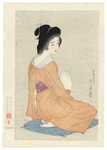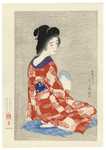| | |
| Artist: | Torii Kotondo (1900-1976) — 鳥居言人 |
| Title: | Long Undergarment (Nagajuban) — 長襦袢 |
| Series: | |
| Date of first edition?: | 1929/7 |
| Date of this artwork?: | 1929 July (may not be accurate) |
| Publisher (first edition)?: | Sakai and Kawaguchi — 酒井川口 |
| Publisher (this edition)?: | Kawaguchi — 川口 |
| Medium (first edition): | Woodblock |
| Medium (this edition): | Woodblock |
| Format (first edition): | Large Oban
|
| Format (this edition): | Large Oban |
| DB artwork code: | 43437 |
| Notes (first edition)?: |
Artist: Torii Kotondo (1900-1976)
Signed: Kotondo saku.
Size: 408 x 261mm (image size).
Editions: 200 (S&K export edition), 300 (S&K domestic edition), 300 (Kawaguchi, with embossed edition cartouche on the verso).
Dated and signed Showa yonen shichigatsu (Showa 4 [1929], 7th month) Kotondo ga, with artist's seal Torii. The title, Nagajuban, embossed at centre of lower margin. Published by Kawaguchi and Sakai. The publisher's seals Sakai Kawaguchi go ban (joint venture) embossed at lower left corner. With limited edition paper label hand-numbered on verso, Gaikoku yuki ni-hyaku mai kagiri zeppan, dai xx go, Torii Kotondo (for foreign export, limited edition of 200 printed, number xx, by Torii Kotondo) with artist's red circular seal Kotondo.
Description: Nagajuban, or "Long Undergarment." This print exists with several colour variations. Here, the swirling marks left purposefully by the printer's baren in the gray background provide a strong textural counterpart to the brilliant red pattern in the robe.
Notes from Ross:
My analysis suggests Sakai/Kawaguchi sold this scene until around edition 130, then passed the remaining stock to Kawaguchi, some with edition labels already attached. 2012: Editon 137 with Sakai/Kawaguchi seals and editioning was sold by Kawaguchi to an American collector before 1936 (collection came to America in 1935), so the transfer of stock to Kawaguchi occurred before edition 137 for the first edition of this scene.
I am not yet convinced there are more than two colour variants. It is possible that most scenes that are suggested to be colour variants simply have faded colours. The blue inks are especially affect. If you have a colour variant not listed in JAODB please email me an image.
In the 1970's Ishukankokai republished twelve Kotondo scenes, but this scene was not included in that series. However, very rare examples of this scene published by Ishukankokai do exist, in two colour states. It would appear that these were issued in a smaller series called "Three Aspects of Women" (Onna San-so). |
|
| Notes (this edition)?: |
| The following information was taken from the original web listing of this artwork. Note that there may be some inaccuracies:
Interesting. This edition contains the Kawaguchi publisher seal but contains the Sakai and Kawaguchi limited edition seal on the verso. Clearly, some of the prints obtained by Kawaguchi from S&K already had the edition seals on the verso. Note the high edition number of 176. My analysis suggests S&K sold this scene until around edition 130, then passed the remaining stock to Kawaguchi, some with edition labels already attached. 2012: Editon 137 with Sakai/Kawaguchi seals and editioning was sold by Kawaguchi to an American collector before 1936 (collection came to America in 1935), so the transfer of stock to Kawaguchi occurred before edition 137 for this scene.
Artist Kotondo
Title Long undergarment
Date 1929
Publisher Kawaguchi
Engraver Ito
Printer Komatsu
Edition 176/200
Format 11 3/4" X 18"
Comment Embossing in the fan; glue residue on upper corners on verso.
The title, Naga Juban, is embossed in the lower margin |
|
| Artist Bio: |
| Torii Kotondo (or Torii Kiyotada VIII) is renowned for his paintings and shin hanga prints of beautiful women. His woodblock prints, superbly carved and printed, are comparable with those of Hashiguchi Goyo and Ito Shinsui. Kotondo was born with the name Saito Akira in the Nihonbashi district of Tokyo. He was the only son among the five children of Torii Kiyotada, the seventh Torii master. The Torii school had a long tradition of painting and printmaking for the Japanese theater, extending back to the seventeenth century. Kabuki theater was still very popular in the early twentieth century and prints and painted posters were the primary means of publicity. Although Kotondo was mainly interested in studying history and archaeology, it was assumed that he would follow in his father's footsteps and join the Torii school. At age 14, Kotondo agreed to leave school and begin studies with Kobori Tomone, a yamato-e painter. Along with painting classes, Tomone taught Kotondo about the court and military practices of ancient Japan, satisfying his interest in history. A year later, he was officially adopted as the next heir of the Torii school and assumed the artist's name 'Kotondo'. While still studying with Tomone, he began designing illustrations for a theatrical magazine, Engei Gaho ('Entertainment Illustrated Magazine'), and painted kabuki posters and billboards. Torii Kotondo was the 8th Torii and the 5th Torii Kiyotada. His father was the 4th Kiyotada.
|
|
































